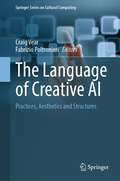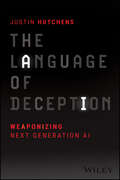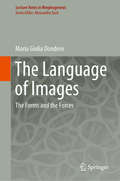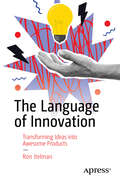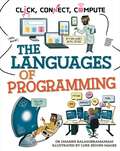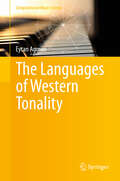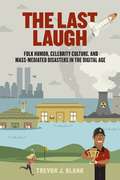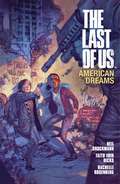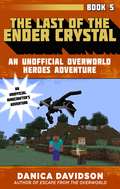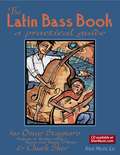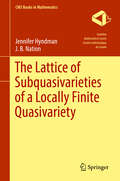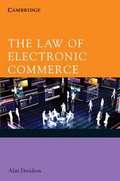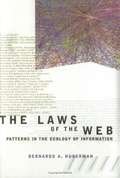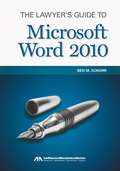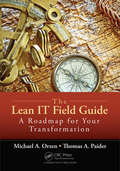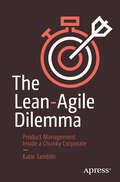- Table View
- List View
The Landscape Photographer's Field Guide: Capturing the Great Outdoors with your Digital SLR Camera
by Carl Heilman IILandscape photography remains one of the most popular genres for enthusiast and commercial photographers alike, but all of the books on the market are large in format and unsuited to use in the field. This latest addition to Ilex's popular Field Guide series meets this need perfectly, with Carl Heilman's unique expertise and brilliant photos presented for the first time in a go-anywhere format.Covering key areas like equipment, exposure, weather and post-processing, and with a handy ready-reference section in the back of the book, The Landscape Photography Field Guide will become an essential companion on any shooting trip.
The Language Phenomenon
by K. Smith P. M. BinderThis volume contains a contemporary, integrated description of the processes of language. These range from fast scales (fractions of a second) to slow ones (over a million years). The contributors, all experts in their fields, address language in the brain, production of sentences and dialogues, language learning, transmission and evolutionary processes that happen over centuries or millenia, the relation between language and genes, the origins of language, self-organization, and language competition and death. The book as a whole will help to show how processes at different scales affect each other, thus presenting language as a dynamic, complex and profoundly human phenomenon.
The Language of Creative AI: Practices, Aesthetics and Structures (Springer Series on Cultural Computing)
by Fabrizio Poltronieri Craig VearCreative AI defines art and media practices that have AI embedded into the process of creation, but also encompass novel AI approaches in the realisation and experience of such work, e.g. robotic art, distributed AI artworks across locations, AI performers, artificial musicians, synthetic images generated by neural networks, AI authors and journalist bots.This book builds on the discourse of AI and creativity and extends the notion of embedded and co-operative creativity with intelligent software. It does so through a human-centred approach in which AI is empowered to make the human experience more creative. It presents ways-of-thinking and doing by the creators themselves so as to add to the ongoing discussion of AI and creativity at a time when the field needs to expand its thinking. This will avoid over-academization of this emerging field, and help counter engrained prejudice and bias. The Language of Creative AI contains technical descriptions, theoretical frameworks, philosophical concepts and practice-based case studies. It is a compendium of thinking around creative AI for technologists, human-computer interaction researchers and artists who are wishing to explore the creative potential of AI.
The Language of Deception: Weaponizing Next Generation AI
by Justin HutchensA penetrating look at the dark side of emerging AI technologies In The Language of Deception: Weaponizing Next Generation AI, artificial intelligence and cybersecurity veteran Justin Hutchens delivers an incisive and penetrating look at how contemporary and future AI can and will be weaponized for malicious and adversarial purposes. In the book, you will explore multiple foundational concepts to include the history of social engineering and social robotics, the psychology of deception, considerations of machine sentience and consciousness, and the history of how technology has been weaponized in the past. From these foundations, the author examines topics related to the emerging risks of advanced AI technologies, to include: The use of Large Language Models (LLMs) for social manipulation, disinformation, psychological operations, deception and fraud The implementation of LLMs to construct fully autonomous social engineering systems for targeted attacks or for mass manipulation at scale The technical use of LLMs and the underlying transformer architecture for use in technical weapons systems to include advanced next-generation malware, physical robotics, and even autonomous munition systems Speculative future risks such as the alignment problem, disembodiment attacks, and flash wars.Perfect for tech enthusiasts, cybersecurity specialists, and AI and machine learning professionals, The Language of Deception is an insightful and timely take on an increasingly essential subject.
The Language of Images: The Forms and the Forces (Lecture Notes in Morphogenesis)
by Maria Giulia DonderoThis book deals with two fundamental issues in the semiotics of the image. The first is the relationship between image and observer: how does one look at an image? To answer this question, this book sets out to transpose the theory of enunciation formulated in linguistics over to the visual field. It also aims to clarify the gains made in contemporary visual semiotics relative to the semiology of Roland Barthes and Emile Benveniste. The second issue addressed is the relation between the forces, forms and materiality of the images. How do different physical mediums (pictorial, photographic and digital) influence visual forms? How does materiality affect the generativity of forms? On the forces within the images, the book addresses the philosophical thought of Gilles Deleuze and René Thom as well as the experiment of Aby Warburg’s Atlas Mnemosyne. The theories discussed in the book are tested on a variety of corpora for analysis, including both paintings and photographs, taken from traditional as well as contemporary sources in a variety of social sectors (arts and sciences). Finally, semiotic methodology is contrasted with the computational analysis of large collections of images (Big Data), such as the “Media Visualization” analyses proposed by Lev Manovich and Cultural Analytics in the field of Computer Science to evaluate the impact of automatic analysis of visual forms on Digital Art History and more generally on the image sciences.
The Language of Innovation: Transforming Ideas into Awesome Products
by Ron ItelmanTransform how teams innovate together and turn your ideas into scalable solutions through practical implementation techniques. Drawing from real-world successes and failures at companies like Apple, Toyota, and Amazon, this book provides a visual language and framework that helps teams align their efforts and reduce risks. Do you struggle to turn creative ideas into reality? Are your innovation projects moving slower than you'd like? Innovation thrives on collaboration, but without the right tools and principles, even brilliant ideas can falter. Through captivating stories and clear frameworks, learn how to create alignment across teams and stakeholders to help make confident strategic choices that minimize risk. You’ll also identify and solve innovation bottlenecks, build systems that scale innovation success, and measure what matters for sustainable growth Whether you're a startup founder, corporate innovator, or team leader, The Language of Innovation equips you with practical tools you can implement immediately using just a whiteboard or spreadsheet. Master the proven principles that help organizations like Amazon turn simple ideas into billion-dollar innovations. What You Will Learn Master the four types of innovation (Process, Business Model, Product, Marketing) and how to apply them effectively Develop systems thinking approaches to understand and improve organizational processes Create effective innovation strategies using proven frameworks and tools Build alignment across teams and stakeholders to drive successful innovation Measure and validate innovation success using data-driven methods Who This Book is For Innovation leaders, product developers, entrepreneurs, and business strategists who need practical frameworks to turn ideas into reality; project managers, business analysts, and cross-functional team leaders who must navigate complex organizational challenges while delivering results; MBA students and business educators interested in understanding real-world innovation dynamics.
The Languages of Programming (Click, Connect, Compute #4)
by Dharini BalasubramaniamComputer language fundamentals, using clear, expert explanations and comic illustrations to spark interest and enthusiasm in the next generation of computer scientists!The Languages of Programming looks at the definitions and uses of languages, bot natural and constructed. Readers will find out about the elements of a programming language, the best types of language to use at each stage of the software life cycle, and about the tools that help to solve difficult programming problems and complex tasks such as monitoring air traffic. And the end of the book fast-forwards to the future of computer science, languages and robotics and considers what it might mean to live in a 'smarter' world.Contents: What is a language? / Languages can come naturally ... / ... or languages can be constructed / Language types for CS / Even more languages! / It's all syntax and semantics / Ways of programming / Choose your language / Programming is a process / Tools to make our work easier / Case study: Blocks vs Python / The future of programming languages / Pioneer portraits / Further information / Glossary / Quiz yourself! / IndexThe Click, Connect, Compute series untangles the computer science web and teaches children about the essentials of computer software, hardware and digital literacy, as well as discussing the ethics surrounding this evolving field. Featuring fun, friendly comic strip illustrations, pioneer bios and a quiz, this is a perfect read for children aged 8+.Books in the series: Computer Science Essentials / Data, Big and Small / Smart Machines / The Languages of ProgrammingWritten in a clear, thoughtful way by computer science expert, Dr. Dharini Balasubramaniam, a strong advocate for ethics and education in her field.
The Languages of Western Tonality
by Eytan AgmonTonal music, from a historical perspective, is far from homogenous; yet an enduring feature is a background "diatonic" system of exactly seven notes orderable cyclically by fifth. What is the source of the durability of the diatonic system, the octave of which is representable in terms of two particular integers, namely 12 and 7? And how is this durability consistent with the equally remarkable variety of musical styles -- or languages -- that the history of Western tonal music has taught us exist? This book is an attempt to answer these questions. Using mathematical tools to describe and explain the Western musical system as a highly sophisticated communication system, this theoretical, historical, and cognitive study is unprecedented in scope and depth. The author engages in intense dialogue with 1000 years of music-theoretical thinking, offering answers to some of the most enduring questions concerning Western tonality. The book is divided into two main parts, both governed by the communicative premise. Part I studies proto-tonality, the background system of notes prior to the selection of a privileged note known as "final. " After some preliminaries that concern consonance and chromaticism, Part II begins with the notion "mode. " A mode is "dyadic" or "triadic," depending on its "nucleus. " Further, a "key" is a special type of "semi-key" which is a special type of mode. Different combinations of these categories account for tonal variety. Ninth-century music, for example, is a tonal language of dyadic modes, while seventeenth-century music is a language of triadic semi-keys. While portions of the book are characterized by abstraction and formal rigor, more suitable for expert readers, it will also be of value to anyone intrigued by the tonal phenomenon at large, including music theorists, musicologists, and music-cognition researchers. The content is supported by a general index, a list of definitions, a list of notation used, and two appendices providing the basic mathematical background.
The Last Laugh
by Trevor J. BlankWidely publicized in mass media worldwide, high-profile tragedies and celebrity scandals the untimely deaths of Michael Jackson and Princess Diana, the embarrassing affairs of Tiger Woods and President Clinton, the 9/11 attacks or the Challenger space shuttle explosion often provoke nervous laughter and black humor. If in the past this snarky folklore may have been shared among friends and uttered behind closed doors, today the Internets ubiquity and instant interactivity propels such humor across a much more extensive and digitally mediated discursive space. New media not only let more people "in on the joke," but they have also become the "go-to" formats for engaging in symbolic interaction, especially in times of anxiety or emotional suppression, by providing users an expansive forum for humorous, combative, or intellectual communication, including jokes that cross the line of propriety and good taste. Moving through engaging case studies of Internet-derived humor about momentous disasters in recent American popular culture and history, The Last Laugh chronicles how and why new media have become a predominant means of vernacular expression. Trevor J. Blank argues that computer-mediated communication has helped to compensate for users sense of physical detachment in the "real" world, while generating newly meaningful and dynamic opportunities for the creation and dissemination of folklore. Drawing together recent developments in new media studies with the analytical tools of folklore studies, he makes a strong case for the significance to contemporary folklore of technologically driven trends in folk and mass culture.
The Last of Us: American Dreams (The Last of Us)
by Neil DruckmannNineteen years ago, a parasitic fungal outbreak killed the majority of the world's population, forcing survivors into a handful of quarantine zones. Thirteen-year-old Ellie has grown up in this violent, postpandemic world, and her disrespect for the military authority running her boarding school earns her new enemies, a new friend in fellow rebel Riley, and her first trip into the outside world. * The official lead-in to the game from Faith Erin Hicks (The Adventures of Superhero Girl) and Naughty Dog's Neil Druckmann!
The Last of the Ender Crystal: An Unofficial Overworld Heroes Adventure, Book Five (Unofficial Overworld Heroes Adventure #5)
by Danica DavidsonAfter searching biome after biome for the lost shards of an enchanted Ender crystal that, in the wrong hands, could ensure the destruction of the entire Overworld, Stevie and Alex have tracked down all but one piece of the crystal. The magical book they’ve been using as a guide is finally fully readable—but several pages are missing!Following the one clue the book still holds, the friends travel through the portal to Earth, where the last shard may be hidden. There they reunite with Maison, who’s just about to celebrate her twelfth birthday. When Maison’s family reveals a secret about her ancestors, the friends realize that Maison may be the only one who can track down the final clues that will lead them to the last Ender shard.Can Stevie, Alex, and Maison uncover long-hidden knowledge and put the clues together in time to reassemble the crystal—and stop the Ender Dragon from breaking free of the End?Fans of Minecraft will rush to put the clues together in the fifth Unofficial Overworld Heroes Adventure!
The Latin Bass Book
by Sher Music Oscar Stagnaro Chuck SherThe only comprehensive book ever published on how to play bass in authentic Afro-Cuban, Brazilian, Caribbean and various South American styles. Over 250 pages of exact transcriptions of every note Oscar plays on the 3 accompanying CDs. Endorsed by Down Beat magazine, Latin Beat magazine, Benny Rietveld, etc.
The Lattice of Subquasivarieties of a Locally Finite Quasivariety (CMS Books in Mathematics)
by Jennifer Hyndman J. B. NationThis book discusses the ways in which the algebras in a locally finite quasivariety determine its lattice of subquasivarieties. The book starts with a clear and comprehensive presentation of the basic structure theory of quasivariety lattices, and then develops new methods and algorithms for their analysis. Particular attention is paid to the role of quasicritical algebras. The methods are illustrated by applying them to quasivarieties of abelian groups, modular lattices, unary algebras and pure relational structures. An appendix gives an overview of the theory of quasivarieties. Extensive references to the literature are provided throughout.
The Law of Electronic Commerce
by Alan DavidsonWritten specifically for legal practitioners and students, this book examines the concerns, laws and regulations involved in Electronic Commerce. In just a few years, commerce via the World Wide Web and other online platforms has boomed, and a new field of legal theory and practice has emerged. Legislation has been enacted to keep pace with commercial realities, cyber-criminals and unforeseen social consequences, but the ever-evolving nature of new technologies has challenged the capacity of the courts to respond effectively. This book addresses the legal issues relating to the introduction and adoption of various forms of electronic commerce. From intellectual property, to issues of security and privacy, Alan Davidson looks at the practical changes for lawyers and commercial parties whilst providing a rationale for the underlying legal theory.
The Laws of Robots: Crimes, Contracts, and Torts
by Ugo PagalloThis book explores how the design, construction, and use of robotics technology may affect today's legal systems and, more particularly, matters of responsibility and agency in criminal law, contractual obligations, and torts. By distinguishing between the behaviour of robots as tools of human interaction, and robots as proper agents in the legal arena, jurists will have to address a new generation of "hard cases." General disagreement may concern immunity in criminal law (e.g., the employment of robot soldiers in battle), personal accountability for certain robots in contracts (e.g., robo-traders), much as clauses of strict liability and negligence-based responsibility in extra-contractual obligations (e.g., service robots in tort law). Since robots are here to stay, the aim of the law should be to wisely govern our mutual relationships.
The Laws of Software Process: A New Model for the Production and Management of Software
by Phillip G. ArmourWithin one generation, software has become one of the principal sources of wealth in the world. The development and use of software has grown faster than for any artifact in the history of the world. Probably no topic or subject in history has accelerated in its rate of practice as software has. Software development now needs to mature into a disciplined activity to overcome the difficulties that have traditionally plagued it. Software developers, engineers, and project managers need a reference that describes the evolution of software: where it has been, and where it is going. The Laws of Software Process: A New Model for the Production and Management of Software reveals a novel and compelling structure for development that redefines the very nature and purpose of software. The author explains how, in the modern "knowledge economy," software systems are not "products" in the classical sense, but is the modern medium for the conveyance of information. Literally, software is the currency of the knowledge basis of wealth in today's society. From this definition flows a new assessment of the basics of software development: the purpose of methods and processes; a comparison of programming languages; and an analysis of quality management, cost estimation, and project management and completion. The groundbreaking perspective outlined in this book serves as an expert guide for successful planning and execution of development projects.
The Laws of Subtraction: 6 Simple Rules for Winning in the Age of Excess Everything
by Matthew MayWinner of a 2013 Small Business Book Award for Economics The world is more overwhelming than ever before. Our work is deeper and more demanding than ever. Our businesses are more complicated and difficult to manage than ever. Our economy is more uncertain than ever. Our resources are scarcer than ever. There is endless choice and feature overkill in all but the best experiences. Everybody knows everything about us. The simple life is a thing of the past. Everywhere, there's too much of the wrong stuff and not enough of the right. The noise is deafening, the signal weak. Everything is too complicated and time-sucking. Welcome to the age of excess everything. Success in this new age looks different and demands a new skill: Subtraction. Subtraction is defined simply as the art of removing anything excessive, confusing, wasteful, unnatural, hazardous, hard to use, or ugly . . . or the discipline to refrain from adding it in the first place. And if subtraction is the new skill to be acquired, we need a guide to developing it. Enter The Laws of Subtraction. Through a dozen of the most compelling stories of breakthrough innovation culled from 2,000 cases and bolstered by uniquely personal essays contributed by over 50 of the most creative minds in business today, The Laws of Subtraction outlines six simple rules for winning in the age of excess everything, and delivers a single yet powerful idea: When you remove just the right things in just the right way, something very good happens. The Laws of Subtraction features contributions by over 50 highly regarded thinkers, creatives, and executives. On Law #1: What Isn't There Can Often Trump What Is "When you reduce the number of doors that someone can walk through, more people walk through the one that you want them to walk through. " -- SCOTT BELSKY, founder and CEO of Behance and author of Making Ideas Happen On Law #2: The Simplest Rules Create the Most Effective Experience "Keeping it simple isn't easy. By exploiting subtraction in innovation, we've been able to create an environment of freedom and creativity that allows us to thrive. " -- BRAD SMITH, CEO, Intuit On Law #3: Limiting Information Engages the Imagination "Subtraction can mean the difference between a highly persuasive presentation and a long, convoluted, and confusing one. Why say more when you can say less?" -- CARMINE GALLO, author of The Apple Experience On Law #4: Creativity Thrives Under Intelligent Constraints "Here's the key to the conundrum for managers who want to stoke the innovation fire: That close cousin of scarcity, constraint, can indeed foster creativity. " -- TERESA AMABILE, author of The Progress Principle On Law #5: Break Is the Important Part of Breakthrough "If you kill the butterflies in your stomach, you'll kill the dream. Embrace the feeling. Save the butterflies. " -- JONATHAN FIELDS, author of Uncertainty On Law #6: Doing Something Isn't Always Better Than Doing Nothing "When we're faced with the greatest odds against us, often we need to edit rather than add. " -- CHIP CONLEY, cofounder of Joie de Vivre Hospitality and author of Emotional Equations
The Laws of the Web: Patterns in the Ecology of Information
by Bernardo A. HubermanDespite its haphazard growth, the Web hides powerful underlying regularities--from the organization of its links to the patterns found in its use by millions of users. Many of these regularities have been predicted on the basis of theoretical models.
The Lawyer's Guide to Microsoft® Outlook 2010
by Ben M. SchorrThe Lawyer's Guide to Microsoft® Outlook 2010 is the only guide written specifically for lawyers to help you be more productive, more efficient and more successful. More than just email, Outlook is also a powerful task, contact, and scheduling manager that will improve your practice.
The Lawyer's Guide to Microsoft® Word 2010
by Ben M. SchorrThis handy reference includes clear explanations, legal-specific descriptions, and time-saving tips for getting the most out of Microsoft Word®--and customizing it for the needs of today's legal professional. Focusing on the tools and features that are essential for lawyers in their everyday practice, The Lawyer's Guide to Microsoft® Word 2010 explains in detail the key components to help make you more effective, more efficient, and more successful.
The Lean Approach to Digital Transformation: From Customer to Code and From Code to Customer
by Yves CaseauThe Lean Approach to Digital Transformation: From Customer to Code and From Code to Customer is organized into three parts that expose and develop the three capabilities that are essential for a successful digital transformation: 1. Understanding how to co-create digital services with users, whether they are customers or future customers. This ability combines observation, dialogue, and iterative experimentation. The approach proposed in this book is based on the Lean Startup approach, according to an extended vision that combines Design Thinking and Growth Hacking. Companies must become truly "customer-centric", from observation and listening to co-development. The revolution of the digital age of the 21st century is that customer orientation is more imperative -- the era of abundance, usages rate of change, complexity of experiences, and shift of power towards communities -- are easier, using digital tools and digital communities. 2. Developing an information system (IS) that is the backbone of the digital transformation – called “exponential information system” to designate an open IS (in particular on its borders), capable of interfacing and combining with external services, positioned as a player in software ecosystems and built for processing scalable and dynamic data flows. The exponential information system is constantly changing and it continuously absorbs the best of information processing technology, such as Artificial Intelligence and Machine Learning. 3. Building software “micro-factories” that produce service platforms, which are called “Lean software factories.” This “software factory” concept covers the integration of agile methods, tooling and continuous integration and deployment practices, a customer-oriented product approach, and a platform approach based on modularity, as well as API-based architecture and openness to external stakeholders. This software micro-factory is the foundation that continuously produces and provides constantly evolving services. These three capabilities are not unique or specific to this book, they are linked to other concepts such as agile methods, product development according to lean principles, software production approaches such as CICD (continuous integration and deployment) or DevOps. This book weaves a common frame of reference for all these approaches to derive more value from the digital transformation and to facilitate its implementation. The title of the book refers to the “lean approach to digital transformation” because the two underlying frameworks, Lean Startup and Lean Software Factory, are directly inspired by Lean, in the sense of the Toyota Way. The Lean approach is present from the beginning to the end of this book -- it provides the framework for customer orientation and the love of a job well done, which are the conditions for the success of a digital transformation.
The Lean IT Expert: Leading the Transformation to High Performance IT
by Niels LoaderDigital transformation is a business concern; it is no longer just IT that must get things done. The disruptive force of start-ups focusing on IT-based services that can be consumed through mobile devices cannot be underestimated -- These start-ups eat away at the high-margin services provided by incumbents, leaving lower margin products and services that are rapidly being commoditized. This is happening in all industry sectors and it is the ones who are best able to adjust, innovate, and improve their service offerings that will survive. The question is: What do you need to do to ensure that your organization is one of the survivors? The core of the solution to the problem is to radically improve the way the IT organization works together with the business. To be clear, the digital transformation of your business depends on that relatively small group of people in the basement, or other out-of-the-way location, who make sure that your IT services work. So, building a cooperative model is vital for the success of the business. Which model has proven its worth in many industries? It is the application of Lean principles that gives organizations an advantage in delivering their products and services to their customers. Transforming your organization to high performance is, above all, a people-based movement with the acquisition and, most importantly, application of knowledge and skills necessary for the high performance way of working at its core. In teams, from boardroom to work floor, building a new way of thinking and acting is essential. This book aims to give insight into the reasons why you and your organization must consciously act to apply Lean principles to your IT organization. It explains the phases organizations go through as they start out with their initial attempts to gain advantages from Lean tools to the phase in which they reap the strategic benefits of Lean applied to IT. The real work of the transformation is described from two different perspectives: Leadership and Team. This book describes a complete set of principles, practices and tools In order to make the right decisions along the winding route of your transformation. The people who will guide, support and drive your transformation are the leaders and tem members who understand and apply those principles, practice and tools: your Lean IT Experts.
The Lean IT Field Guide: A Roadmap for Your Transformation
by Michael A. Orzen Thomas A. PaiderHow many IT books have you read that are long on theory and short on practical application? They are interesting, but not very impactful. They provide a framework from which to think and understand, but lack a process from which to act. Addressing this urgent need for the IT community, The Lean IT Field Guide explains how to initiate, execute, and sustain a lean IT transformation.Illuminating a clear path to lean IT, the authors integrate more than two decades of combined experience to provide you with a proven method for creating and sustaining a true lean IT workplace. This field guide not only highlights the organizational techniques of more agile and lean processes, but also the leadership work required to help management adopt these new approaches.Based on proven methods from different industries, including banking, manufacturing, insurance, food and beverage, and logistics, the book details a clear model that covers all the components you need to achieve and sustain a favorable work environment and culture in support of lean IT.Filled with anecdotes and case studies from actual businesses, the book includes pictures, templates, and examples that illustrate the application of the lean methods discussed.
The Lean IT Field Guide: A Roadmap for Your Transformation
by Michael A. Orzen Thomas A. PaiderHow many IT books have you read that are long on theory and short on practical application? They are interesting, but not very impactful. They provide a framework from which to think and understand, but lack a process from which to act. Addressing this urgent need for the IT community, The Lean IT Field Guide explains how to initiate, execute, and sustain a lean IT transformation.Illuminating a clear path to lean IT, the authors integrate more than two decades of combined experience to provide you with a proven method for creating and sustaining a true lean IT workplace. This field guide not only highlights the organizational techniques of more agile and lean processes, but also the leadership work required to help management adopt these new approaches.Based on proven methods from different industries, including banking, manufacturing, insurance, food and beverage, and logistics, the book details a clear model that covers all the components you need to achieve and sustain a favorable work environment and culture in support of lean IT.Filled with anecdotes and case studies from actual businesses, the book includes pictures, templates, and examples that illustrate the application of the lean methods discussed.
The Lean-Agile Dilemma: Product Management Inside a Chunky Corporate
by Katie TamblinOver the last decade, Lean-Agile principles have become the standard methodology by which product and technology teams operate. However, Lean-Agile was written for small companies seeking new markets to buy their innovative software products, not for an average corporation with a catalogue of existing software products that must be maintained and rebuilt. The typical tech-enabled business isn't a lean startup; it's a chunky corporate. This book offers an alternative software development methodology perfectly suited for chunky corporate product management. You’ll quickly find out how individual players in the corporate organization impact business performance. You’ll follow the story of Blake, a well-meaning but ultimately naive, CEO of a fictional company called Acme Tech. As he and Acme struggle to maintain business performance, it becomes apparent how embedded and complex his challenges are. Lean-Agile principles are regularly misapplied in the corporate environment, causing tension, missed deadlines, and inefficient working practices. You’ll see that managing software transformation at a large, mature business requires a new set of tools. Popular development methodologies are not well-suited for the replatforming exercises that chunky corporates inevitably face. This book helps product and technology leaders navigate software development projects at organizations grappling with the constraints of investor ownership. Chunky corporates have a lot going for them: The Lean-Agile Dilemma reveals that, when managed well, they have the potential to be safe havens in a relentlessly unstable world. You will: Understand how replatforming differs from new product development Learn how to manage existing data when updating or building new software Gain tools to prioritize items in your overstuffed product roadmap Who This Book is For Product managers, product owners, product leadership, tech leadership, and business leaders at mature tech-enabled businesses.


